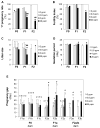Multigenerational exposure to dietary zearalenone (ZEA), an estrogenic mycotoxin, affects puberty and reproduction in female mice
- PMID: 24972337
- PMCID: PMC4137769
- DOI: 10.1016/j.reprotox.2014.06.005
Multigenerational exposure to dietary zearalenone (ZEA), an estrogenic mycotoxin, affects puberty and reproduction in female mice
Abstract
This study investigated potential cumulative effects of multiple pregnancy and multigenerational exposure to dietary ZEA (0, 0.8, 4, or 20ppm) on female puberty and reproduction in C57BL/6J mice. Multiple pregnancies did not significantly affect litter size or offspring puberty. Significant effects were observed in 20ppm ZEA-treated females: advanced puberty onset in F0, F1, and F2 generations; decreased implantation rate, pregnancy rate, and litter size, and increased pregnancy gap and gestation period in F1 and F2 generations; and reduced fertility index in F2 generation. F3 females from 0 and 20ppm groups were split into 0 or 20ppm ZEA diets at weaning, with advanced puberty onset seen in 0-20 and 20-20 groups and decreased implantation rate observed in 20-20 group. In summary, 20ppm dietary ZEA advanced puberty onset without obvious cumulative effect and impaired fertility with multigenerational cumulative effect, which could be partially alleviated upon exposure cessation.
Keywords: Embryo implantation; Female reproduction; Litter size; Multigeneration; Multipregnancy; Vaginal opening; Zearalenone.
Copyright © 2014 Elsevier Inc. All rights reserved.
Figures





Similar articles
-
Postweaning exposure to dietary zearalenone, a mycotoxin, promotes premature onset of puberty and disrupts early pregnancy events in female mice.Toxicol Sci. 2013 Apr;132(2):431-42. doi: 10.1093/toxsci/kfs343. Epub 2013 Jan 5. Toxicol Sci. 2013. PMID: 23291560 Free PMC article.
-
Two-generation reproductive toxicity evaluation of dietary 17beta-estradiol (E2; CAS No. 50-28-2) in CD-1 (Swiss) mice.Toxicol Sci. 2008 Apr;102(2):392-412. doi: 10.1093/toxsci/kfn002. Epub 2008 Jan 8. Toxicol Sci. 2008. PMID: 18184636
-
Gestational exposure to 2,3,7,8-tetrachlorodibenzo-p-dioxin (TCDD) severely alters reproductive function of female hamster offspring.Toxicol Sci. 1999 Oct;51(2):259-64. doi: 10.1093/toxsci/51.2.259. Toxicol Sci. 1999. PMID: 10543027
-
Endocrine disrupting compounds: effect of octylphenol on reproduction over three generations.Theriogenology. 2001 Jan 1;55(1):131-50. doi: 10.1016/s0093-691x(00)00451-9. Theriogenology. 2001. PMID: 11198078 Review.
-
Male reproductive toxicity of zearalenone-meta-analysis with mechanism review.Ecotoxicol Environ Saf. 2021 Sep 15;221:112457. doi: 10.1016/j.ecoenv.2021.112457. Epub 2021 Jun 25. Ecotoxicol Environ Saf. 2021. PMID: 34175827
Cited by
-
Novel function of LHFPL2 in female and male distal reproductive tract development.Sci Rep. 2016 Mar 11;6:23037. doi: 10.1038/srep23037. Sci Rep. 2016. PMID: 26964900 Free PMC article.
-
Single-cell transcriptomic profiling provides insights into the toxic effects of Zearalenone exposure on primordial follicle assembly.Theranostics. 2021 Mar 5;11(11):5197-5213. doi: 10.7150/thno.58433. eCollection 2021. Theranostics. 2021. PMID: 33859742 Free PMC article.
-
Segregated responses of mammary gland development and vaginal opening to prepubertal genistein exposure in Bscl2(-/-) female mice with lipodystrophy.Reprod Toxicol. 2015 Jul;54:76-83. doi: 10.1016/j.reprotox.2014.10.023. Epub 2014 Nov 5. Reprod Toxicol. 2015. PMID: 25462787 Free PMC article.
-
Oxidative stress induced by zearalenone in porcine granulosa cells and its rescue by curcumin in vitro.PLoS One. 2015 Jun 1;10(6):e0127551. doi: 10.1371/journal.pone.0127551. eCollection 2015. PLoS One. 2015. PMID: 26030649 Free PMC article.
-
Zearalenone induces apoptosis and autophagy by regulating endoplasmic reticulum stress signalling in porcine trophectoderm cells.Anim Nutr. 2022 Oct 5;12:186-199. doi: 10.1016/j.aninu.2022.08.016. eCollection 2023 Mar. Anim Nutr. 2022. PMID: 36712409 Free PMC article.
References
-
- Zinedine A, Soriano JM, Molto JC, Manes J. Review on the toxicity, occurrence, metabolism, detoxification, regulations and intake of zearalenone: an oestrogenic mycotoxin. Food Chem Toxicol. 2007;45:1–18. - PubMed
-
- EFSA. Scientific Opinion on the risks for public health related to the presence of zearalenone in food. EFSA Journal. 2011;9:2197.
-
- Massart F, Saggese G. Oestrogenic mycotoxin exposures and precocious pubertal development. Int J Androl. 2010;33:369–76. - PubMed
-
- Deng F, Tao FB, Liu DY, Xu YY, Hao JH, Sun Y, et al. Effects of growth environments and two environmental endocrine disruptors on children with idiopathic precocious puberty. Eur J Endocrinol. 2012;166:803–9. - PubMed
Publication types
MeSH terms
Substances
Grants and funding
LinkOut - more resources
Full Text Sources
Other Literature Sources
Miscellaneous

